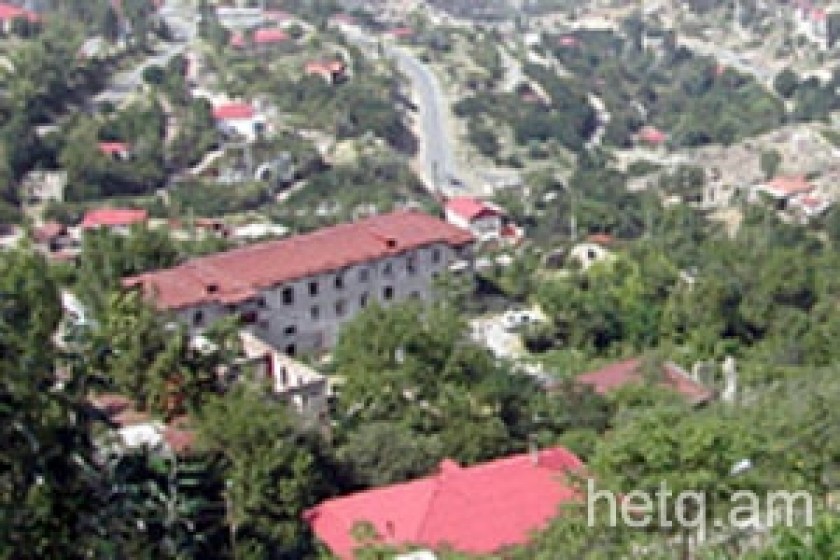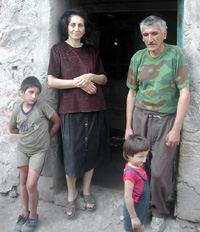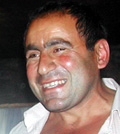
Illusions and Reality: Villages in Kashatagh Still Don’t Have Budgets
Tsaghkaberd, the largest village in the Kashatagh region of Nagorno Karabakh, has about 1,000 hectares of arable land. 600 hectares is allocated to the villagers for cultivation, but only few of them are able to make use of their land.
“It takes 100,000 drams (about $250) to sow one hectare of land, if everything else is in a normal state – fertilizers, etc. After living here for four or five years a villager can get a 120,000-dram-loan for livestock breeding, with no other opportunities. The people who come here aren't rich – they are mostly poor people. It takes $1,500 to sow their eight hectares of land. Naturally, none of them has that kind of money,” said Azat Yeghoyan, the head of local administration of Tsaghkaberd.
Those villagers who can lease machinery from the village of Khndzoresk near Goris; others lease out their land.
“It would be much better if we had the machinery. My fields have been ripe for a month now but I can't lease a combine harvester. Every passing day brings losses. Serious losses caused by the lack of machinery. This is one of the main problems,” Yeghoyan explained.
In the last twelve years, the government has not built a single house in Tsaghkaberd. The residents have appealed to the local administration many times but they've only gotten a few thousand drams in assistance.
“The state has to invest, say, 20 million drams to provide this area with electric power but it does it over twenty years because it doesn't have the capacity or doesn't consider it important. For the state, it is more important to pave a few streets in Yerevan with asphalt. A question arises: what is more important for the nation – building houses in these territories, populating them, or paving three more streets in Yerevan? The state has allocated to our region 300 million drams; if we deduct social payments, it comes to about $500,000. What can you do with a half a million dollars? This includes the construction of schools, hospitals, houses, water pipelines for drinking and irrigation. It's a tiny sum, and that's what has led to this situation. The villages in Nagorno Karabakh, as well as villages in the Meghri region of Armenia, are in the same condition. It is better there, perhaps, in the sense that the houses are built. Here, we lack even that. In Meghri the issue of the irrigation water has not been solved yet, but the Meghri region is strategically more significant than the city of Abovyan, for example. But the situation in Abovyan is much better than in Meghri,” the local mayor added.
The villages of Kashatagh don't have budgets today. Yet for five years now, they've been collecting rent for land from the farmers. This rent adds up to a lot of money – tens of millions of drams—but no one can say where this money goes. If it had remained in the village communities, they could have acquired their own technical resources long ago. Of course, there are people who don't pay any rent at all. They cultivate the land, even have contracts signed, but they don't pay. These people are mainly army generals and various government officials.
At present, rental agreements are signed with the head of the Kashatagh administration, and the community heads are unaware of who is renting land in their villages.
 Forty-four-year-old Marat Harutyunyan moved from Goris to the village of Hakari with his wife and three children more than ten years ago.
Forty-four-year-old Marat Harutyunyan moved from Goris to the village of Hakari with his wife and three children more than ten years ago.
“We were living in a rented place, so I came here to live. I was the first resident – we came in 1995. My fourth child, Ani was born here in 2001,” Marat said proudly.
The family settled in the biggest house in the village, even though it had no roof and was burned out. Today, the house is still fairly ramshackle.
“I haven't received any assistance from the state, and I haven't applied for it either. This house was in ruins; I've brought it to this condition – I did what I could. I was trained as a construction worker. I have two cows and two calves. It's not much and I want to get more, but I can't manage – there are too many problems,” Marat complained.
“Do you want to go back to Goris?” I asked.
“How can I go back, where would I live? I want to go, but I don't have even a doghouse there. Where can I go? I feel sorry for my kids – they don't know about anything; we are cut off from the outside world” Marat said, then added, “We don't live too badly, don't go hungry, we get by.”
The family receives 16,000 drams (about $40) for four children. They earn their living with their vegetable garden. As to why they haven't expanded, Marat explained, “You have to have money to start a bit larger business. We don't; that's why we are unable to expand. My son is nearsighted, but for five years we didn't have the money to buy glasses for him. Finally, last winter, we managed to buy them. Here we live okay, we help each other, get by together. If anything happens, everyone comes to help. We needed a little of help from the state to get on our feet, but we never got it. That's why we are in this condition.”
 The head of the village administration, Garnik Chobanyan has lived in Hakari here since 1995. His two children were born here. “I don't know why I came here, I just decided to and came,” Garnik said. “I had small business in Yerevan. I got tired of it and moved here. I have 22 head of cattle, including 6 milk cows. I had no idea about village work, I learned everything here.”
The head of the village administration, Garnik Chobanyan has lived in Hakari here since 1995. His two children were born here. “I don't know why I came here, I just decided to and came,” Garnik said. “I had small business in Yerevan. I got tired of it and moved here. I have 22 head of cattle, including 6 milk cows. I had no idea about village work, I learned everything here.”
The mayor sees the absence of a market for local produce as the region's main problem. In spring and autumn, people come from Goris in cars to get milk, but in the summer, villagers can't sell their products; the cars don't come because the milk turns sour.
“It would be great if we could turn milk into other products here; otherwise every one has to try to sell their milk on their own. If villagers produce goods and can't sell them, what can they do? They raise cattle but can't sell it. In the past, they used to come here and buy, but now no one does. The more the price for goods goes up, the less the demand is,” Garnik said.
Garnik believes that a program for developing this area needs to be adopted. “The way out is to help the villagers. No, I don't mean food, clothes. We don't need that kind of help. We have to bring in the machinery for cultivating our land from outside. The villagers are unable to fertilize the soil, to cultivate the land properly. In Armenia, villagers get the fertilizers and later pay for it with the harvest, or there are other ways. Here there are no loans. I applied several times to get a tractor. I went to Yerevan to apply for a Japanese tractor and I was told that Kashatagh was not entitled to it,” the mayor said, and wondered, “Why aren't we entitled to it? Isn't this Armenia?”
Kashatagh-Yerevan
 Videos
Videos Photos
Photos
Write a comment